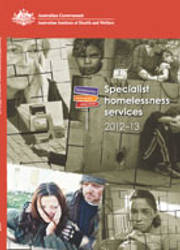Summary
An estimated 244,000 Australians accessed specialist homelessness services in
2012‒13―an increase of 3% from 2011‒12
The number of clients supported by specialist homelessness services increased in all states and territories except for New South Wales, Tasmania, and the Australian Capital Territory. Victoria accounted for 81% of the overall national increase due to the commencement of a number of newly-funded specialist homelessness agencies.
The profile of clients assisted in 2012‒13 was generally similar to 2011‒12
More than half of all clients were at risk of homelessness (54%) when they first began receiving support. Of those who were homeless when presenting (46%), 22% had no shelter or were staying in improvised dwellings and 35% were in short-term accommodation.
Most clients who received assistance were female (59%). However, males were more likely to be homeless when they first received support, including being more likely to be living with no shelter or in an improvised dwelling (28% of homeless males compared to 16% of homeless females).
Indigenous Australians continue to be over-represented. Although representing 3% of the total Australian population, Indigenous people represented 22% of specialist homelessness services clients.
Domestic and family violence remains a leading cause of homelessness. Thirty-two per cent of all clients receiving assistance from homelessness agencies were escaping domestic or family violence. The majority of these were adult females (63%) and 19% were children under 10 years of age.
Agencies help many clients secure a source of income to assist in meeting housing costs. The proportion of these clients who had no income went from 17% at the beginning of support to 10% at the end of support. The proportions of clients whose main source of income was a government benefit or employee income both increased slightly.
For those who identified a need for employment assistance, the proportion employed at the end of support increased from 12% to 20%, with the increase in clients employed part-time rising from 8% to 13%.
Agencies were able to support a number of clients into more stable housing. Overall, the proportion of clients who ended support in private housing remained steady, but the proportion of clients in public or community housing increased from 15% at the start of support to 21% at the end of support.
There were some shifts in the characteristics of clients from 2011‒12
There was an increase of 14% from 2011-12 in the number of people aged 55 years and over seeking support from specialist homelessness agencies.
Agencies reported more clients who had been 'couch surfing' or otherwise living without tenure. This group increased in number by 26% from 2011-12.
The estimated average number of unassisted requests for assistance each day increased to 417 in 2012‒13 from 385 in 2011‒12, but there was a decrease in the proportion of clients experiencing repeat periods of homelessness.
Preliminary material: Acknowledgments; Abbreviations; Symbols
1 Introduction
- The policy framework for reducing homelessness
- About the Specialist Homelessness Services Collection
- About this report
- Revision of 2011‒12 SHSC data
2 A profile of clients and services provided
- At a glance
- Changes among specialist homelessness services clients from the previous year
- Characteristics of clients
- Clients' needs for assistance and services provided
- Support periods
3 Client outcomes following support
- Housing outcomes
- Other outcomes for clients
4 Comparisons of key client groups
- Information on analyses presented in this chapter
- Indigenous clients
- Overseas-born clients
- Homeless and at-risk clients
- Clients by geographic area
5 Other client groups of special interest
- Families and children
- Young people presenting alone
- Older clients
- Clients who have experienced domestic and family violence
- Clients with a current mental health issue
- Clients leaving care
- Clients exiting custodial arrangements
- Children on a care and protection order
6 Unmet demand for specialist homelessness services
- Unassisted requests for assistance
- Unmet need for services
Appendixes
Appendix A
Appendix B
End matter: List of tables; List of figures; Related publications



